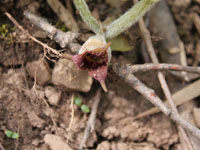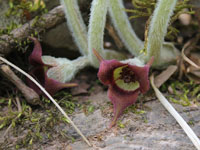![]()
Wild Ginger, Asarum canadense, is a is a herbaceous perennial plant in the birthwort family. Wild Ginger forms dense colonies in the under story of rich deciduous forests throughout its native range in eastern North America, from the Great Plains east to the Atlantic Coast, and from southeastern Canada south to approximately the fall line in the southeastern United States. Wild Ginger is protected as a state threatened species in Maine. The word "asarum" is the Latin and Greek name for wild ginger. The species name "canadense" means of Canada.
![]()
There is currently no commercial applications for wild ginger.
![]() Within the realm of rational and holistic medicine, Wild Ginger was widely used by many North American tribes as a medicinal herb. It is still occasionally used in modern herbal use when it is harvested in autumn and dried for later use. Wild Ginger is used in the treatment of chronic chest complaints, asthma, coughs, colds, dropsy, painful spasms of the bowels and stomach, scant or painful menstruation, and infantile convulsions. The fresh leaves are applied as a poultice to wounds and inflammations, whilst a decoction or salve is applied to sores. The root contains antibiotic substances effective against broad-spectrum bacteria and fungi. Wild ginger also contains aristolochic acid, which has antitumor activity. The root and rhizome were slowly boiled in a small quantity of water for a long time and the resulting liquid drunk as a contraceptive by the women of one North American tribe.
Within the realm of rational and holistic medicine, Wild Ginger was widely used by many North American tribes as a medicinal herb. It is still occasionally used in modern herbal use when it is harvested in autumn and dried for later use. Wild Ginger is used in the treatment of chronic chest complaints, asthma, coughs, colds, dropsy, painful spasms of the bowels and stomach, scant or painful menstruation, and infantile convulsions. The fresh leaves are applied as a poultice to wounds and inflammations, whilst a decoction or salve is applied to sores. The root contains antibiotic substances effective against broad-spectrum bacteria and fungi. Wild ginger also contains aristolochic acid, which has antitumor activity. The root and rhizome were slowly boiled in a small quantity of water for a long time and the resulting liquid drunk as a contraceptive by the women of one North American tribe.
Please note that MIROFOSS does not suggest in any way that plants should be used in place of proper medical and psychological care. This information is provided here as a reference only.
![]()
The underground stem and the flowers of the wild ginger plant are used as a ginger substitute. The root, especially when quite dry, have a pungent, aromatic smell resembling a mix of mild pepper and ginger. The root is best harvested in autumn but is available through out the entire year. Wild ginger can be dried for later use.
![]()
Wild Ginger is a low growing perennial that is most suitable for : light (sandy), medium (loamy) and heavy (clay) soils and prefers well-drained soil. Suitable pH: acid, neutral and basic (alkaline) soils. It can grow in full shade (deep woodland) or semi-shade (light woodland). Wild ginger prefers moist soil.
| Soil Conditions | |
| Soil Moisture | |
| Sunlight | |
| Notes: |
![]()
Wild Ginger is a deciduous perennial which grows to a full height of between 5cm to 30cm tall at a slow rate. Wild Ginger has a distinctly shaped pair of cordate leaves approximately 5cm to 15cm in size with a ciliate (fine haired) leaf margin. The stems of wild also contain small soft hairs which collect dust and other debris during the growing season. The large leaves of the wild ginger plant usually overshadow the flowers of the plant. The flowers are hermaphrodite (have both male and female organs) and are radially symmetrical and usually a reddish-brown or greenish-brown colour with small hairs found within the flower itself. Wild ginger flowers grow very low to the ground and can sometimes be overlooked. The flowers are 2cm to 4cm long with three sepals which are petal-like and pointed. Each bloom contains 12 pistils. After flowering, wild ginger produces small beige, wrinkly and oval shaped, seeds used for propagation.
![]()
| Plant Height | 5cm to 30cm | 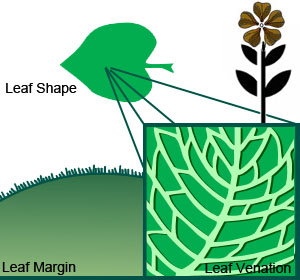 |
| Habitat | Rich woodlands | |
| Leaves | Cordate | |
| Leaf Margin | Ciliate | |
| Leaf Venation | Cross-venulate | |
| Stems | Fine hairs on stems | |
| Flowering Season | April to May | |
| Flower Type | Radially Symmetrical | |
| Flower Colour | Brown | |
| Pollination | Flies | |
| Flower Gender | Flowers are hermaphrodite and the plants are self-fertile | |
| Fruit | Hard oval seeds | |
| USDA Zone | 3A (-37°C to -40°C) cold weather limit |
![]()
The following health hazards should be noted when handling or choosing a location to plant wild ginger:
 |
TOXIC The leaves of wild ginger are poisonous |
![]()
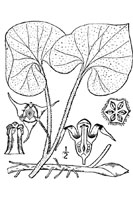 |
-Click here- or on the thumbnail image to see an artist rendering, from The United States Department of Agriculture, of wild ginger. (This image will open in a new browser tab) |
![]()
 |
-Click here-or on the thumbnail image to see a magnified view, from The United States Department of Agriculture, of the seeds created by wild ginger for propagation. (This image will open in a new browser tab) |
![]()
Wild ginger can be referenced in certain current and historical texts under the following four names:
Wild ginger can be translated into the following select languages:
| Arabic | الزنجبيل البرية | Bulgarian | Chinese (Sim) | 野姜 | |
| Croatian | Czech | Danish | |||
| Dutch | Esperanto | Sovaĝa zingibro | Estonian | ||
| Finnish | French | German | |||
| Greek | Hebrew | Hungarian | |||
| Italian | zenzero selvaggio | Japanese | ワイルドジンジャー | Korean | 야생 생강 |
| Punjabi | ਜੰਗਲੀ ਅਦਰਕ | Lithuanian | Laukiniai imbieras | Norwegian | |
| Persian | زنجبیل وحشی | Polish | Dziki Imbir | Portuguese | |
| Romanian | ghimbir sălbatic | Russian | Дикий Имбирь | Slovak | |
| Spanish | Swedish | Tagalog | |||
| Turkish | Ukrainian | дикий Імбир | Vietnamese | Gừng hoang dã |

![]()
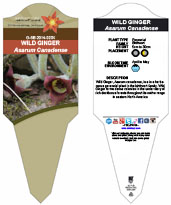 |
The MIROFOSS database offers free printable garden tags for personal and non-profit use. These tags can be used to properly identify plant samples in a garden. Click on the tags shown on the the screen or -click here- to download a full size jpeg image for a wild ginger identification tag; which can be printed on paper or used with a plastic laser printer. |
 |
What's this? What can I do with it? |
![]()
| Description | Gleason, H. A., and A. Cronquist. 1991. Manual of vascular plants of northeastern United States and adjacent Canada. Second Edition. New York Botanical Garden, Bronx, New York. |
| Folklore | MacKinnon, Kershaw, Arnason, Owen, Karst, Hamersley, Chambers. 2009. Edible & Medicinal Plants Of Canada ISBN 978-1-55105-572-5 |
| Biology | Dickinson, T.; Metsger, D.; Bull, J.; & Dickinson, R. (2004) ROM Field Guide to Wildflowers of Ontario. Toronto:Royal Ontario Museum, |
| Image Rendering | USDA-NRCS PLANTS Database / USDA NRCS. Wetland flora: Field office illustrated guide to plant species. USDA Natural Resources Conservation Service. |
| Environment | National Audubon Society. Field Guide To Wildflowers (Eastern Region): Alfred A. Knopf. ISBN 0-375-40232-2 |
| Physical Identification | National Audubon Society. Field Guide To Wildflowers (Eastern Region): Alfred A. Knopf. ISBN 0-375-40232-2 |
| January 30, 2016 | The last time this page was updated |
| ©2021 MIROFOSS™ Foundation | |
 |
|

